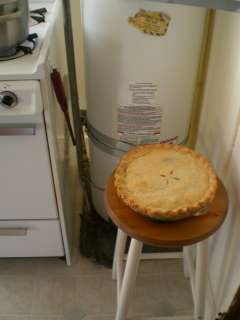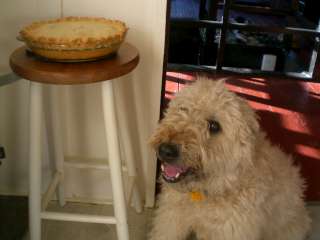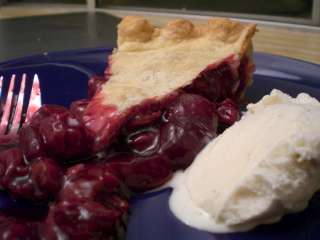Fruits + Vodka + Lard
Wednesday, July 22nd, 2009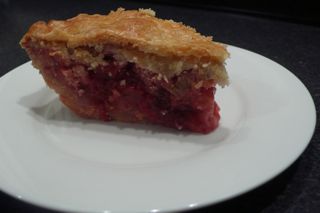 There is some magic in making a good pie crust. Even Nigella admits to being trepidatious about anything pastry. Indeed, I’m always at least a little anxious when making pie crust because there are so many details that could result in flabby, or glutinous, or hard, or flaky crust: the ratio of shortening to butter must be correct, the fats must be cold, the water must be icy, the dough mustn’t be massaged too thoroughly, the dough must be rested and chilled- but not too much, or it will crack when rolled out… No wonder nobody makes pies anymore when just the crust has so many potential pitfalls and one can buy a pie so much more easily.
There is some magic in making a good pie crust. Even Nigella admits to being trepidatious about anything pastry. Indeed, I’m always at least a little anxious when making pie crust because there are so many details that could result in flabby, or glutinous, or hard, or flaky crust: the ratio of shortening to butter must be correct, the fats must be cold, the water must be icy, the dough mustn’t be massaged too thoroughly, the dough must be rested and chilled- but not too much, or it will crack when rolled out… No wonder nobody makes pies anymore when just the crust has so many potential pitfalls and one can buy a pie so much more easily.
But there’s something to be said for homemade pie. One earns extra points when serving pie for dessert if it’s homemade, and even more points if even the filling is from scratch. If keeping score, Marc recently earned extra bonus points for a pie that not only had amazing crust and a scrumptious, sweet-tart filling, but which could be extracted from the pie plate cleanly and without any spill-over. Of course, there is no human alive that would turn down a slice if, during serving, it comes apart and spills over becoming somewhat unrecognizable as actual pie, but it portends a certain suave genius to serve a piece of pie that looks like it could be on display. His creation was of the strawberry-rhubarb variety, my second all-time favourite; apart from it’s perfect execution, I’m sure part of its deliciousness was owing to the absolutely perfect – truly perfect – strawberries contained within. Wow, those strawberries were blue-ribbon quality. What a difference buying local and vine ripened makes; they were deep red and just the purest essence of strawberry. The grocery store was selling them right next to a shiny basket of new rhubarb, thus making the mental leap from strawberry to rhubarb to pie that much more obvious. We happily walked right into that one.
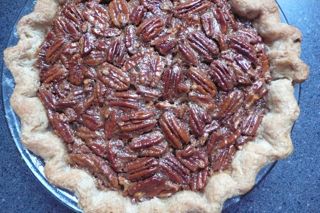
Before this, there was pecan pie, made only because of the surplus of pecans in the freezer. Those nuts only last so long and Trader Joe’s only sells them in enormous bags, so having bought the enormous bag, we were committed. Only 475 calories per slice.
The pecan pie was a revelation as it was the first pie crust we made with vodka. Yes, it turns out, that in addition to cocktails and sauce for penne, vodka can be used in pie dough. The recipe came from an episode of America’s Test Kitchen and explained the science behind the addition of vodka:
While gluten (the protein that makes crust tough) forms readily in water, it doesn’t form in ethanol, and vodka is 60 percent water and 40 percent ethanol. So adding 8 tablespoons of vodka produces a moist, easy-to-roll dough that stays tender (because it contains only 6 1/2 tablespoons of water). The alcohol vaporizes in the oven.
And now, forever more, I will add vodka to pie crust: partly as a practical step towards good pie, and partly as a superstitious sacrifice to the forces that grant a flaky crust.
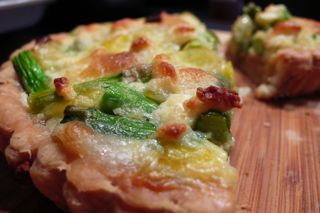
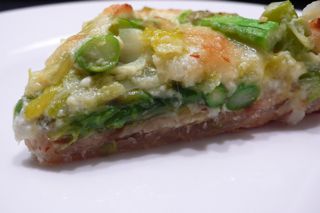
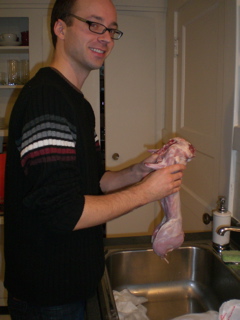
 Like a fool, I just grabbed a bag from the bin at the Berkeley Bowl that read “$3.69/lb” assuming – and this is where I went wrong – that they were one-pound bags. I mean, I don’t know how much a pound is, it just seemed logical. Marc wanted a second bag for eating and so we came home with an unexpected cherry expense of $15.99. Which seems outrageous at first but we would’ve spent that on a bottle of wine, so relatively speaking, I guess it is reasonable.
Like a fool, I just grabbed a bag from the bin at the Berkeley Bowl that read “$3.69/lb” assuming – and this is where I went wrong – that they were one-pound bags. I mean, I don’t know how much a pound is, it just seemed logical. Marc wanted a second bag for eating and so we came home with an unexpected cherry expense of $15.99. Which seems outrageous at first but we would’ve spent that on a bottle of wine, so relatively speaking, I guess it is reasonable.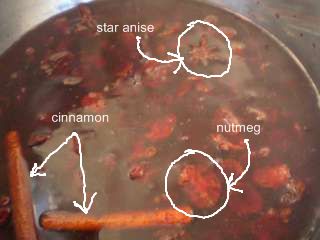 The remainder of the dried ones are going to be great in scones or muffins and the remainder of the bings are quickly disappearing as breakfast food. Notice the aromatics; I wouldn’t have thought to add these on my own.
The remainder of the dried ones are going to be great in scones or muffins and the remainder of the bings are quickly disappearing as breakfast food. Notice the aromatics; I wouldn’t have thought to add these on my own. Pictured at left is the cooked filling, which took about 40 minutes to make and over an hour to cool. Meanwhile, I made the
Pictured at left is the cooked filling, which took about 40 minutes to make and over an hour to cool. Meanwhile, I made the 